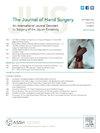Risk Factors for Nonunion After Distal Phalangeal Fractures of the Hand
IF 2.1
2区 医学
Q2 ORTHOPEDICS
引用次数: 0
Abstract
Purpose
This study aimed to evaluate the risk factors for distal phalanx fracture nonunion.
Methods
We retrospectively reviewed all adult patients treated for distal phalanx fractures at our institution between January 2015 and December 2019 with a minimum one-year follow-up period for potential risk factors. The absence of consolidation signs on follow-up radiographs at least 12 months after trauma was defined as nonunion.
Results
This study included 124 patients with 143 fractures available for follow-up. Nonunion was diagnosed in 19 patients, 18 of whom initially presented with an open fracture. On the day of the injury, 17 patients with open fractures presented to the hospital. In 16 nonunion cases, the traumatic mechanism was a crush injury. All nonunions occurred in tuft fractures, and none required revision surgery at the follow-up visit.
Conclusions
Our findings suggest that tuft involvement in open fractures is the main risk factor for nonunion of distal phalangeal fractures. However, after a minimum of 1 year of follow-up, none of the tuft nonunions required revision surgery.
Type of study/level of evidence
Therapeutic IV.
手部远端指骨骨折后骨不连的危险因素。
目的:本研究旨在评估远端指骨骨折不愈合的危险因素。方法:我们回顾性分析了2015年1月至2019年12月期间在我院接受远端指骨骨折治疗的所有成年患者,并对潜在危险因素进行了至少一年的随访。创伤后至少12个月的随访x线片上没有实变征象被定义为骨不连。结果:本研究纳入124例可随访的143例骨折患者。19例患者被诊断为骨不连,其中18例最初表现为开放性骨折。受伤当天,17名开放性骨折患者到医院就诊。在16例骨不连病例中,创伤机制为挤压伤。所有骨不连均发生在簇状骨折中,随访时均不需要翻修手术。结论:我们的研究结果表明,开放性骨折的簇状骨受累是远端指骨骨折不愈合的主要危险因素。然而,在至少1年的随访后,没有一例丛状骨不连需要翻修手术。研究类型/证据水平:治疗性IV。
本文章由计算机程序翻译,如有差异,请以英文原文为准。
求助全文
约1分钟内获得全文
求助全文
来源期刊
CiteScore
3.20
自引率
10.50%
发文量
402
审稿时长
12 weeks
期刊介绍:
The Journal of Hand Surgery publishes original, peer-reviewed articles related to the pathophysiology, diagnosis, and treatment of diseases and conditions of the upper extremity; these include both clinical and basic science studies, along with case reports. Special features include Review Articles (including Current Concepts and The Hand Surgery Landscape), Reviews of Books and Media, and Letters to the Editor.

 求助内容:
求助内容: 应助结果提醒方式:
应助结果提醒方式:


